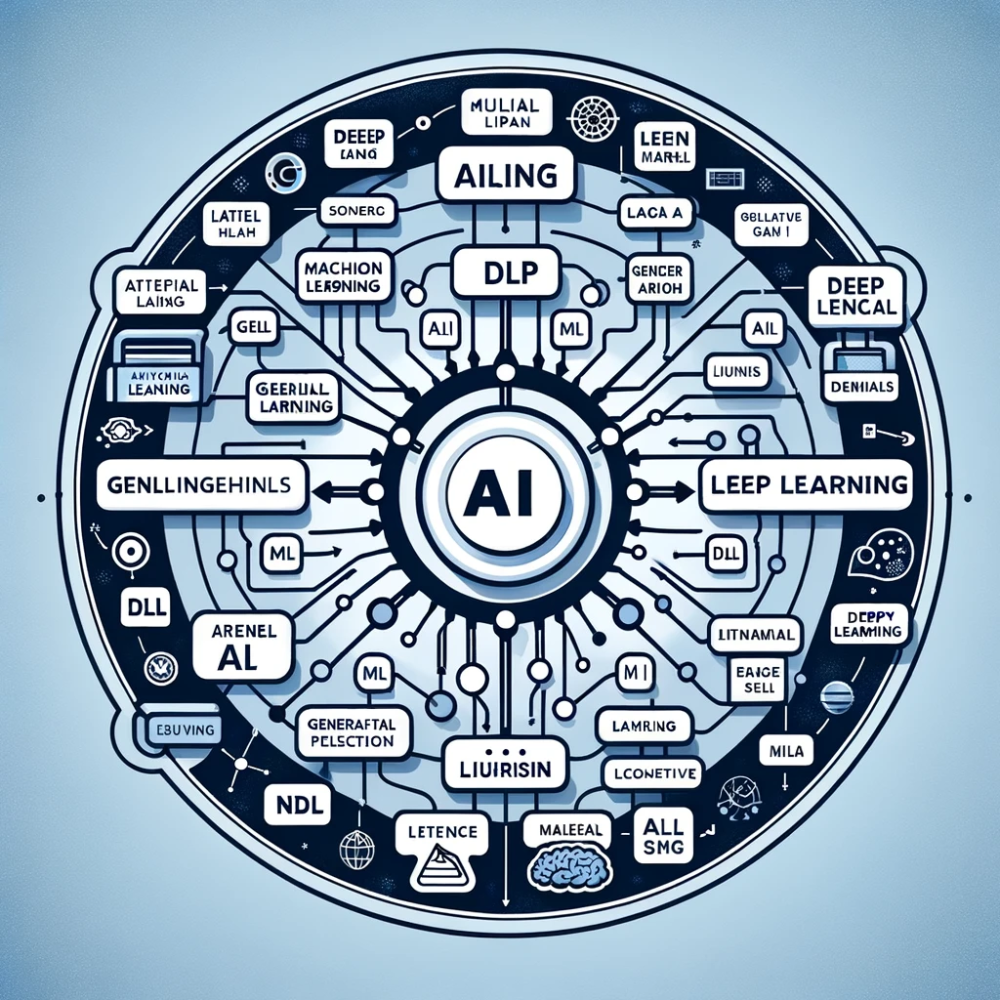50 Useful AI Terms Everyone Should Know
Artificial Intelligence (AI) is rapidly transforming the world, from how we work and communicate to how we learn and create. As this technology evolves, so does the vocabulary surrounding it. Whether you’re a beginner or an enthusiast, understanding the basic terminology can help you navigate the AI landscape with confidence.
Here are 50 useful AI terms you should know in 2025 to stay updated and informed:
1. Artificial Intelligence (AI)
A branch of computer science that aims to create machines capable of intelligent behavior.
2. Machine Learning (ML)
A subset of AI where computers learn from data and improve over time without being explicitly programmed.
3. Deep Learning
A more advanced form of ML using neural networks with many layers to mimic the human brain’s processing.
4. Neural Networks
Algorithms designed to recognize patterns by mimicking the structure of the human brain.
5. Natural Language Processing (NLP)
A field of AI that helps computers understand, interpret, and generate human language.
6. Large Language Model (LLM)
A deep learning model trained on vast amounts of text data to understand and generate natural language.
7. Prompt Engineering
Crafting the right inputs (prompts) to get desired outputs from language models.
8. Generative AI
AI systems that can create new content, such as text, images, music, or code.
9. Transformer
An architecture that powers most LLMs like GPT, BERT, etc., allowing AI to handle sequences of data efficiently.
10. Chatbot
An AI application that simulates human-like conversation, often used in customer service.
11. Supervised Learning
A type of ML where the model is trained on labeled data.
12. Unsupervised Learning
Learning patterns from data without labeled outcomes.
13. Reinforcement Learning
A learning technique where an agent learns to make decisions by performing actions and receiving rewards or penalties.
14. Computer Vision
An AI field focused on enabling machines to interpret visual information.
15. Bias in AI
The presence of prejudice in AI algorithms, usually due to biased training data.
16. Ethical AI
The practice of designing and using AI in ways that uphold human values and fairness.
17. Explainable AI (XAI)
AI that provides human-understandable explanations for its decisions.
18. Data Labeling
The process of assigning labels to data points to help train supervised learning models.
19. Training Data
The dataset used to teach an AI model how to make decisions or predictions.
20. Inference
The process where an AI model applies what it has learned to make predictions or decisions.
21. Overfitting
When a model learns training data too well, leading to poor performance on new data.
22. Underfitting
When a model is too simple to capture the underlying patterns in the data.
23. Fine-tuning
Adapting a pre-trained model to a specific task using a smaller dataset.
24. Zero-shot Learning
Making predictions on tasks the model has never seen before.
25. Few-shot Learning
Training an AI model on a limited number of examples.
26. Artificial General Intelligence (AGI)
A theoretical form of AI that can understand and perform any intellectual task a human can.
27. Artificial Narrow Intelligence (ANI)
AI that’s specialized in one task (e.g., image recognition or playing chess).
28. Turing Test
A test proposed by Alan Turing to determine if a machine can exhibit human-like intelligence.
29. Tokenization
Breaking down text into smaller pieces (tokens) for easier processing by language models.
30. OpenAI
A leading AI research organization that developed models like GPT and ChatGPT.
31. GPT (Generative Pre-trained Transformer)
A type of LLM developed by OpenAI used in applications like ChatGPT.
32. Anthropic
An AI safety and research company known for developing Claude AI.
33. Hallucination (in AI)
When an AI model generates information that is not factual or grounded in reality.
34. API (Application Programming Interface)
A way for applications to communicate with each other, often used to integrate AI services.
35. Model Weights
The parameters learned by an AI model during training.
36. Dataset
A collection of data used to train or evaluate an AI model.
37. Synthetic Data
Artificially created data used to supplement real-world datasets.
38. Open Source AI
AI tools and frameworks that are publicly available for anyone to use or modify.
39. Bias Mitigation
Techniques used to reduce bias in AI systems.
40. AI Ethics Board
A group responsible for overseeing ethical guidelines in AI development.
41. Knowledge Graph
A network of real-world entities and their relationships used to enhance AI understanding.
42. Data Preprocessing
Preparing raw data for use in a machine learning model.
43. Latent Space
A representation of data in a compressed form that preserves essential features.
44. Cloud AI
AI services provided through cloud platforms like AWS, Azure, or Google Cloud.
45. Self-Supervised Learning
A form of learning where the model generates its own labels from the data.
46. AI Alignment
Ensuring that AI goals and behaviors align with human values.
47. Token Limit
The maximum number of tokens a language model can process in one request.
48. Multimodal AI
AI systems that can understand and generate multiple types of data (e.g., text, image, audio).
49. AI Agent
An autonomous AI system that can perform tasks or make decisions with minimal human input.
50. Singularity (AI)
A hypothetical point where AI surpasses human intelligence, leading to rapid, unforeseeable changes in society.
Conclusion
Understanding these terms is a great first step toward embracing AI in your daily life or career. As AI continues to evolve in 2025 and beyond, staying fluent in this terminology will help you stay ahead of the curve. Whether you’re a student, professional, entrepreneur, or simply curious, knowing these 50 AI terms will boost your confidence in conversations and help you engage more meaningfully with the AI-driven world.
The Rise of Autonomous AI Agents in Workflows: Altman’s 2025 Vision Becomes Reality
https://bitsofall.com/ai-powered-governments-can-machines-govern-better-than-humans/



